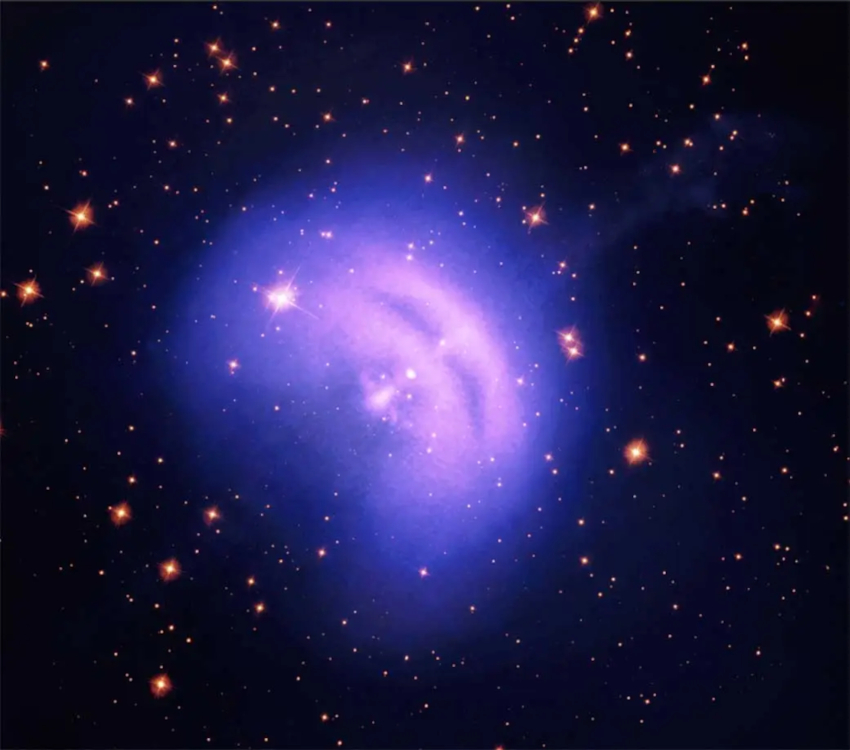
 Credit: X-ray: (IXPE) NASA/MSFC/Fei Xie & (Chandra) NASA/CXC/SAO; Optical: NASA/STScI Hubble/Chandra processing by Judy Schmidt; Hubble/Chandra/IXPE processing & compositing by NASA/CXC/SAO/Kimberly Arcand & Nancy Wolk
Credit: X-ray: (IXPE) NASA/MSFC/Fei Xie & (Chandra) NASA/CXC/SAO; Optical: NASA/STScI Hubble/Chandra processing by Judy Schmidt; Hubble/Chandra/IXPE processing & compositing by NASA/CXC/SAO/Kimberly Arcand & Nancy Wolk
Polarized Pulsar Wind
X-ray pulsars are tiny, fast spinning neutron stars which have small, X-ray bright "hot spots" near the neutron star surface. As the neutron star spins, the hot spots come in and out of view, producing flashes of X-rays similar to the flashes of visible light produced by a lighthouse. A particularly good example of an X-ray pulsar is the Vela pulsar, a neutron star in the constellation of Vela (a constellation named for the sails of the legendary ship the Argo). The Vela pulsar is the collapsed remnant of the core of a star that exploded in our Galaxy more that 10,000 years ago, and it has been spinning 11 times per second and flashing all that time. The pulsar has a strong magnetic field, which helps shape a narrow beam (or jet) of high energy subatomic particles which blasts into space. Particles accelerated from the Vela pulsar interact with surrounding clouds of matter in the Galaxy, producing an extended glowing region of X-rays which astronomers call a "pulsar wind nebula". The X-ray emission from the pulsar wind nebula offers important clues about how pulsars accelerate electrons and protons to nearly the speed of light. The pulsar wind nebula produced by the Vela pulsar is shown in the image above, a composite of X-ray and optical images. The X-ray nebula is best seen in data from the Chandra X-ray Observatory, shown as two concentric arcs of pink and purple in the image above. The blue glow around the nebula represents the X-ray polarization in the pulsar wind nebula as seen by the Imaging X-ray Polarimetry Explorer (IXPE). X-ray polarization measured by IXPE is produced by organized motion of charged particles in the nebula as they spiral around magnetic field lines. The high degree of polarization measured by IXPE in X-rays, and also by ground-based radio observatories, indicates that the magnetic field in the nebula is highly organized. This suggests that random shocks, which can be important in accelerating charged particles to high speed in other nebulae, are not so important in accelerating the charged particles in Vela's pulsar wind nebula. It also suggests that the pulsar's magnetic field has a simple toroidal (or donut) shape, unlike the more complicated structures seen in other pulsars.
Published: September 9, 2024
<
HEA Dictionary ● Archive
● Search HEAPOW
● Other Languages
● HEAPOW on Facebook
● Download all Images
● Education ● HEAD
>

Each week the HEASARC
brings you new, exciting and beautiful images from X-ray and Gamma ray
astronomy. Check back each week and be sure to check out the HEAPOW archive!
Page Author: Dr. Michael F. Corcoran
Last modified Monday, 16-Sep-2024 13:14:30 EDT


